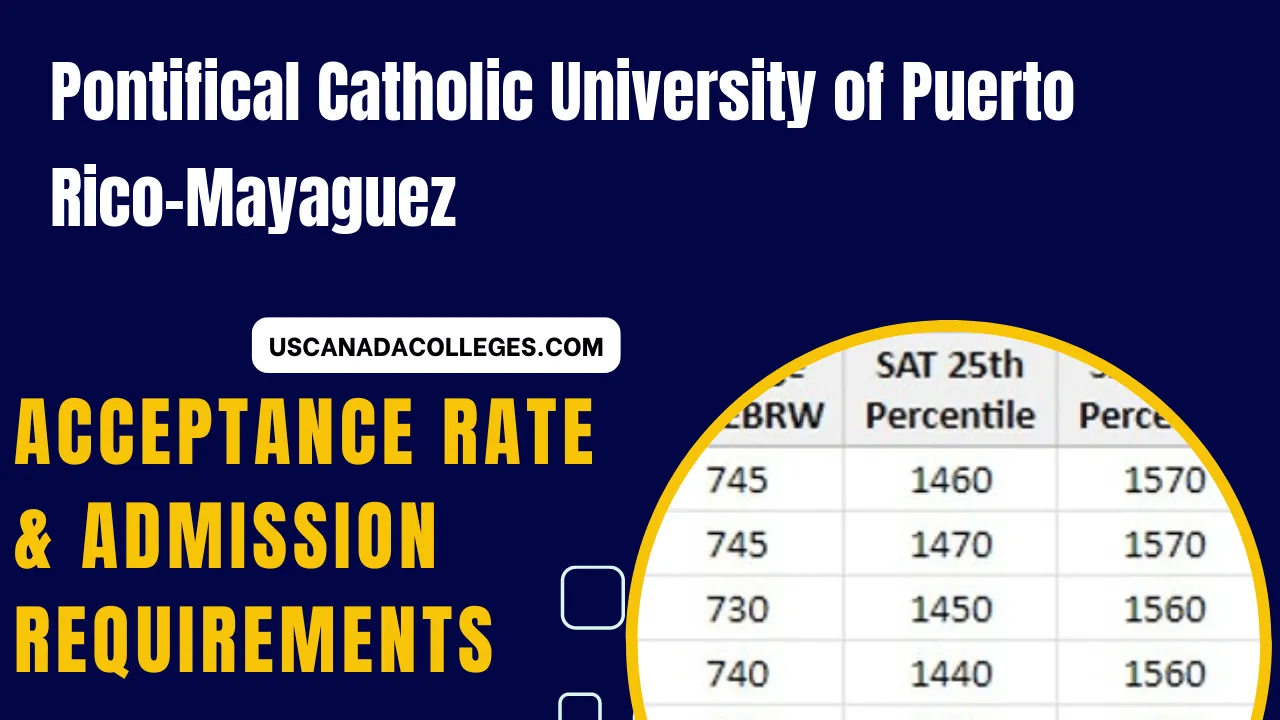Pontifical Catholic University of Puerto Rico-Mayaguez is not selective in its admission process. The acceptance rate of Pontifical Catholic University of Puerto Rico-Mayaguez (PUCPR-Mayaguez) is 100%. This means that all applicants are admitted.
How Competitive are Pontifical Catholic University of Puerto Rico-Mayaguez Admissions?
- Not Competitive: Applicants with satisfactory academics can easily secure admission.
- A holistic review considers essays, recommendations, and leadership roles.

However, a 100% acceptance rate or open admission policy does not guarantee admission. Every institution has minimum eligibility criteria. If you meet these conditions, then you can be certain of admission. Additionally, to secure admission, you must convince the admission staff that you are mentally and physically fit for the course of studies.
Pontifical Catholic University of Puerto Rico-Mayaguez Admission Requirements
Can I Get Into PUCPR-Mayaguez Without SAT Or ACT?: Pontifical Catholic University of Puerto Rico-Mayaguez considers admission test scores (SAT/ACT) during the application process but does not require them. Although it is not strictly a requirement, the test scores are considered for admission decisions. Hence, it is advisable to prepare well for the test and submit the best scores. Normally, students may appear in the test 4 to 5 times to improve their scores. Hence you are required to plan early and appear in upcoming SAT / ACT tests. Check the schedule of the test and plan accordingly. It is advisable to appear multiple times in the test unless you score well above the average SAT / ACT score of the admitted students, as given below.
Pontifical Catholic University of Puerto Rico-Mayaguez (PUCPR-Mayaguez) SAT Requirements
Each school has different requirements for SAT and ACT testing. Only a few schools require the SAT or ACT, but many consider your scores if you choose to submit them. The test score policy is already mentioned.
PUCPR-Mayaguez Profile
Name: Pontifical Catholic University of Puerto Rico-Mayaguez (PUCPR-Mayaguez)
City: Mayaguez
State: Puerto Rico
Type: Non-Profit Private
Zip: 00680-1713
Campus: Branch Campus
Accredited by: Middle States Commission on Higher Education (MSACHE)
How much does a degree from PUCPR-Mayaguez Cost?
The average annual cost of the degree at Pontifical Catholic University of Puerto Rico-Mayaguez is USD: 14460. As most of the students receive Pell Grants and Federal Grants the average annual net price a student has to pay at Pontifical Catholic University of Puerto Rico-Mayaguez is much less than this.
How can I get a scholarship?
80.34% of the students are receiving Pell Grant and 25.88 percent are receiving Federal Grants. So it is a better choice to go to PUCPR-Mayaguez and apply for PELL or federal loan grants.
At Pontifical Catholic University of Puerto Rico-Mayaguez, you will have no problem receiving any scholarship from the federal government. Fill in the FAFSA application form at the earliest and enlist PUCPR-Mayaguez as your choice in the form.
How much a PUCPR-Mayaguez Graduate make?
The average annual salary of the PUCPR-Mayaguez graduate after 4-6 years of graduation is USD 24908. An average PUCPR-Mayaguez graduate makes this much after 10 years of enrollment (4-6 years after graduation).
The average annual income of a graduate in the United States is USD: 40595
Degree Programs
Bachelor Degree Programs
- Accounting and Related Services
- Biology, General
- Business Administration, Management and Operations
- Business Operations Support and Assistant Services
- Business/Commerce, General
- Clinical, Counseling and Applied Psychology
- Communication and Media Studies
- Computer and Information Sciences, General
- Criminal Justice and Corrections
- Criminology
Frequently Asked Questions About Pontifical Catholic University of Puerto Rico-Mayaguez Admissions
Answer: Graduates of this university typically earn a lower salary, $24908 annually, especially in non-technical fields.
Question: What is the tuition fee for Pontifical Catholic University of Puerto Rico-Mayaguez?
Answer: The tuition fee at this university is relatively low, around $14460 per year, making it more affordable for many students.
Question: What are my chances of getting a scholarship at Pontifical Catholic University of Puerto Rico-Mayaguez?
Answer: Your chances of getting a scholarship are excellent, with more than a 80% chance, depending on your academic performance and extracurricular involvement.
Question: What is the acceptance rate for Pontifical Catholic University of Puerto Rico-Mayaguez?
Answer: The acceptance rate of Pontifical Catholic University of Puerto Rico-Mayaguez is 99.77 which is relatively high, above 20%, making it somewhat easier to gain admission compared to other top-tier universities.
Question: Is it possible to transfer to Pontifical Catholic University of Puerto Rico-Mayaguez from another university?
Answer: Yes, many students successfully transfer to Pontifical Catholic University of Puerto Rico-Mayaguez each year. Be prepared with your academic transcripts, recommendation letters, and a solid personal statement to make your application competitive.
Question: What is the campus culture like at Pontifical Catholic University of Puerto Rico-Mayaguez?
Answer: The campus culture at Pontifical Catholic University of Puerto Rico-Mayaguez is diverse and vibrant, with numerous student organizations, sports teams, and cultural activities. It’s an ideal environment for personal growth and building lifelong connections.
Question: How can I improve my chances of getting into Pontifical Catholic University of Puerto Rico-Mayaguez?
Answer: To improve your chances, focus on excelling academically, building a strong extracurricular profile, and submitting standout essays. High SAT/ACT scores are also crucial for competitive admissions.
Full list of All degree programs offered by Pontifical Catholic University of Puerto Rico-Mayaguez.
Data on this page is sourced from IPEDS, College Scorecard's latest data as provided in 2025, US Department of Education's latest 2025 statistics, Institute's official websites and printed material as well as additional publicly available sources.
